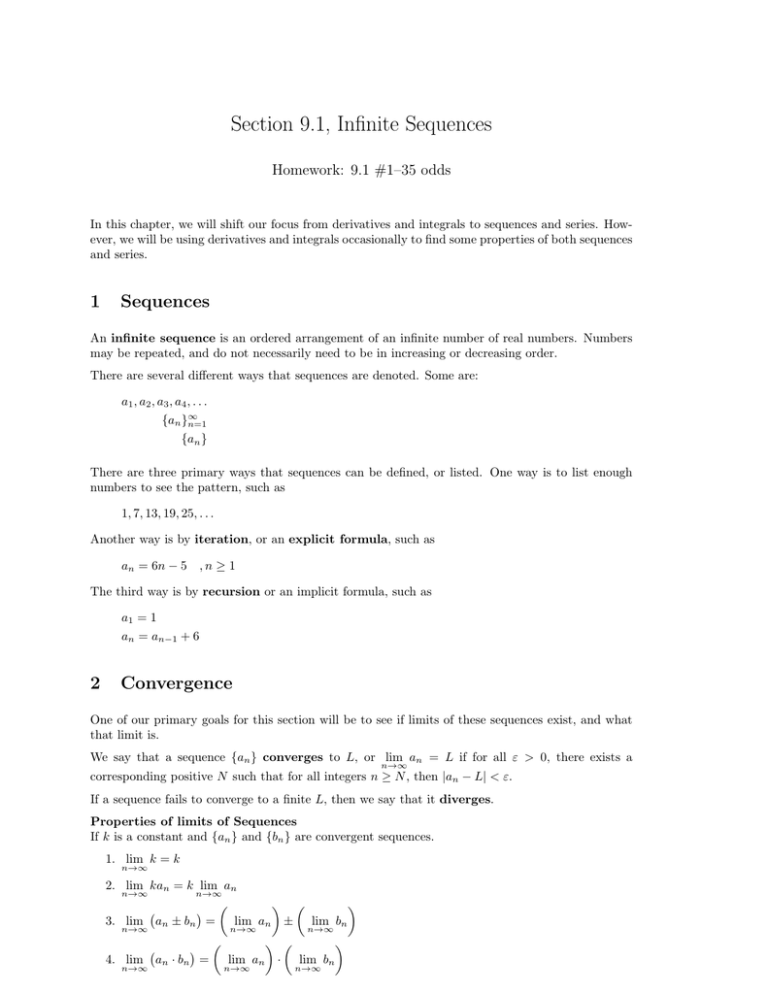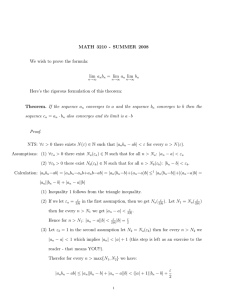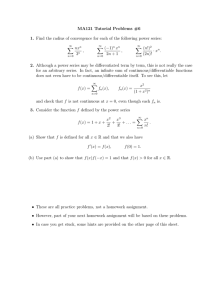Section 9.1, Infinite Sequences Homework: 9.1 #1–35 odds
advertisement

Section 9.1, Infinite Sequences
Homework: 9.1 #1–35 odds
In this chapter, we will shift our focus from derivatives and integrals to sequences and series. However, we will be using derivatives and integrals occasionally to find some properties of both sequences
and series.
1
Sequences
An infinite sequence is an ordered arrangement of an infinite number of real numbers. Numbers
may be repeated, and do not necessarily need to be in increasing or decreasing order.
There are several different ways that sequences are denoted. Some are:
a1 , a2 , a3 , a4 , . . .
{an }∞
n=1
{an }
There are three primary ways that sequences can be defined, or listed. One way is to list enough
numbers to see the pattern, such as
1, 7, 13, 19, 25, . . .
Another way is by iteration, or an explicit formula, such as
an = 6n − 5
,n ≥ 1
The third way is by recursion or an implicit formula, such as
a1 = 1
an = an−1 + 6
2
Convergence
One of our primary goals for this section will be to see if limits of these sequences exist, and what
that limit is.
We say that a sequence {an } converges to L, or lim an = L if for all ε > 0, there exists a
n→∞
corresponding positive N such that for all integers n ≥ N , then |an − L| < ε.
If a sequence fails to converge to a finite L, then we say that it diverges.
Properties of limits of Sequences
If k is a constant and {an } and {bn } are convergent sequences.
1. lim k = k
n→∞
2. lim kan = k lim an
n→∞
n→∞
3. lim an ± bn =
lim an ± lim bn
n→∞
4. lim an · bn =
n→∞
n→∞
n→∞
lim an · lim bn
n→∞
n→∞
an
limn→∞ an
=
if limn→∞ bn 6= 0
n→∞ bn
limn→∞ bn
5. lim
Another helpful property that we can use is that if f (x) is a continuous function and lim f (x) = L,
x→∞
then lim f (n) = L where the n in the second limit represents only positive integer values. This
n→∞
means that we can use L’Hôpital’s Rule, even though the derivative doesn’t exist when x can only
be integer values.
Examples
Determine whether the sequence converges or diverges, and, if it converges, find lim an .
n→∞
n
Also Write the first 4 terms of this sequence.
1. an =
2n − 1
2 3 4
n
The first 4 terms are 1, , , . This sequence converges to 1/2 since
converges to 1/2.
3 5 7
2n − 1
2. an =
5n2 − 3n + 1
2n2 + 7
This converges to 5/2.
3. an =
ln(1/n)
√
2n
By L’Hôpital’s Rule,
lim
x→∞
ln(1/x)
− ln x
√
= lim
x→∞ (2x)1/2
2x
−1/x
= lim
x→∞ (2x)−1/2
−(2x)1/2
=0
x→∞
x
= lim
so the sequence converges to 0.
4. an =
n200
en
x200
200x199
=
lim
x→∞ ex
x→∞
ex
200 · 199x198
= lim
= ...
x→∞
ex
200!
= lim x
x→∞ e
0
= lim x = 0,
x→∞ e
lim
so the sequence converges to 0.
The Squeeze Theorem says that if {an } and {cn } both converge to L and an ≤ bn ≤ cn for n ≥ k,
where k is some fixed integer, then {bn } also converges to L.
A direct result of this is that if lim |an | = 0, then lim an = 0.
n→∞
n→∞
Example
Determine if {an }, where an = e−n sin n converges. If so, find the limit.
Since −1 ≤ sin n ≤ 1, −e−n ≤ e−n sin n ≤ e−n . We know that both −e−n and e−n converge to 0,
so e−n sin n also converges to 0.
Monotonic Sequence Theorem
If U is an upper bound for a nondecreasing sequence {an }, then the sequence converges to a limit A
that is less than or equal to U . Similarly, if L is a lower bound for a nonincreasing sequence {bn },
then the sequence {bn } converges to a limit B that is greater than or equal to L.
Example
n
1
Show that {an } converges if an =
2− 2 .
n+1
n
n
n
This sequence is nondecreasing, since both n+1
and 2 − n12 are nondecreasing. Since n+1
≤ 1 and
1
2 − n2 ≤ 2, an ≤ 1 · 2 = 2, so we have an upper bound for the sequence. Therefore, by the Monotonic
Sequence Theorem, the sequence converges.





